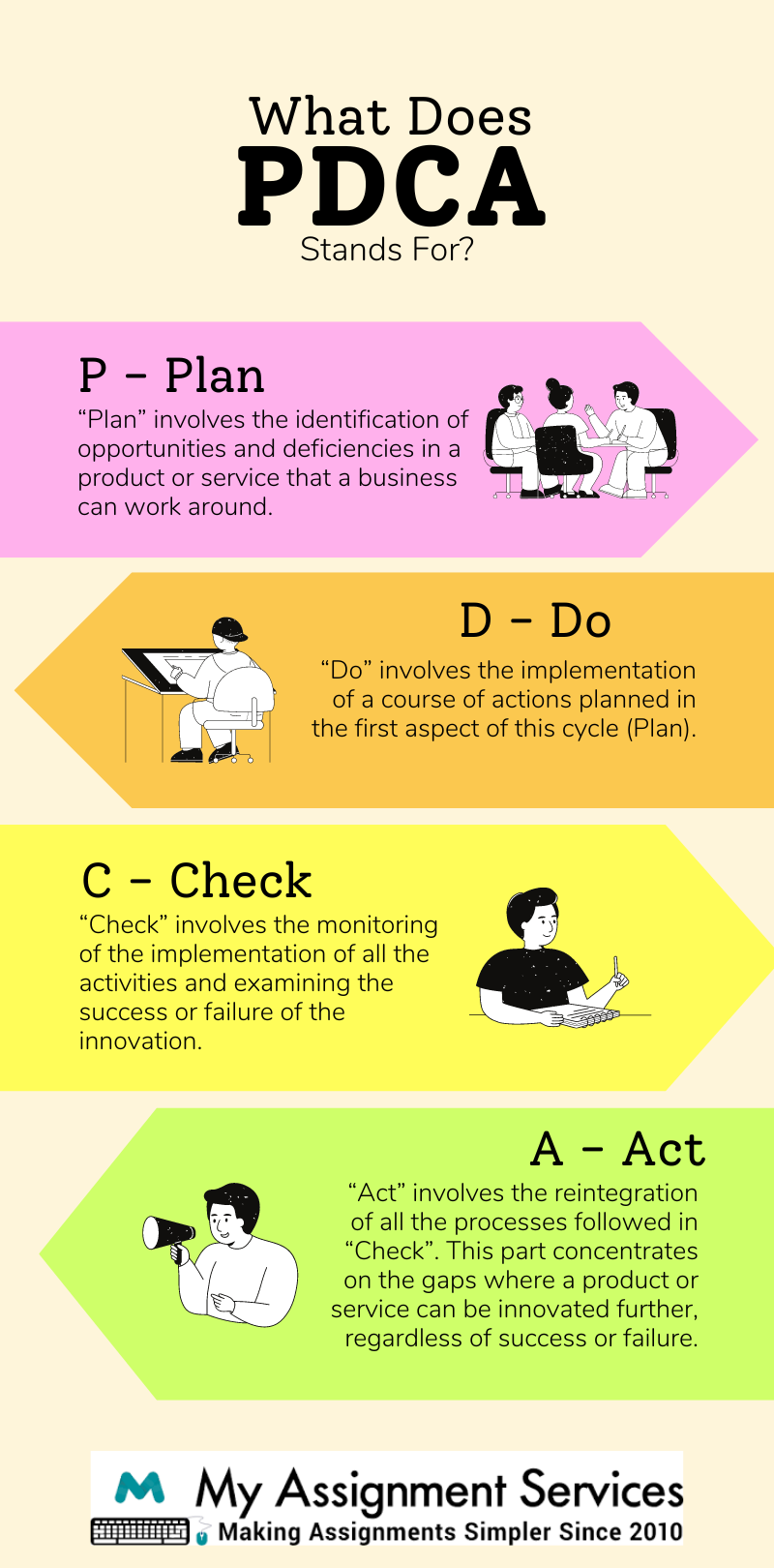The PDCA cycle is a systematic cycle that manages the overall growth and development of the business’s products and services. This cycle is a major part of any organisation’s business conduct and cycle of operations. It is important for all business management students to learn and understand the theory of PDCA. You can be a student who is going to own and manage a business or will manage someone else’s business. Either way, the theory of this cycle is going to ensure that you are ready to conduct business operations effectively.
This cycle is also known as the PDCA Deming cycle because of Dr. Deming, who introduced the theory to the world. It has come into existence over a long period of time as it went through an evolutionary process. If you are a business management student, you are probably familiar with the cycle but not its detailed history. Knowing the basic history of PDCA will help you develop multidimensional perspectives. The history will also provide you with multidisciplinary insights into this theory’s relevance in business management and ethics.

The History Of The PDCA
The Deming wheel PDCA cycle came into existence because of a staggering blend of scientific theories and philosophical inclinations. The father of modern science, Dr. Galileo Galilei, was an inventor who built many inventions during his course of life. He originally designed all the inventions and worked on building them with his comprehension of mathematics. Father of Empiricism, Sir Francis Bacon, who was an English philosopher, talked about knowledge because of Galileo. He said that we sow the seeds of knowledge through a specific structure with consideration and planning.
With this philosophy, the PDCA cycle started to emerge from the roots of knowledge and reasoning. Because of the American philosopher and pragmatist C. I. Lewis, who also wrote on ethics, influenced Shewhart and Deming. Walter A. Shewhart, who was the father of statistical quality control, introduced the Shewhart cycle. It explained a straight-lined process with three steps consisting of -
- Specification
- Production
- Inspection
William Edwards Deming, who was a student of Shewhart, restructured the Shewhart cycle into a more well-defined structure of processes. The seeds of the PDCA Deming cycle were sown in 1951 by Deming in a seminar. He explained to the Japanese Union of Scientists and Engineers the four steps: design, production, sales, and research. In 1950, the cycle was built with these main steps to increase the quality of a product or service. Deming’s “PDCA” went through an evolution over the course of years, transforming into “PDSA” in 1993. While PDCA involves the process of “check”, PDSA involves the process of “study”. Let’s break down the PDCA now.
Following P - D - C - A
The Deming wheel PDCA cycle talks about the four aspects of improving the quality of any product or service. Pay attention to this because business management students will benefit from this breakdown. These four aspects are explained below:
P (Plan)
“Plan” involves the identification of opportunities and deficiencies in a product or service that a business can work around. This part involves the formulation of a thesis with the objective of revitalising the product or service. When students build reports of PDCA, this is what they overlook the most often, leading to lower grades.
D (Do)
“Do” involves the implementation of a course of actions planned in the first aspect of this cycle. This part identifies the opportunities and deficiencies associated with the product or service. Students representing the practical application of any product or service have to consider taking suggestions from their peers and mentors.
C (Check)
“Check” involves the monitoring of the implementation of all the activities and examining the success or failure of the innovation. This can generally be a tricky one because the PDSA cycle involves “study” and it means a whole different thing. Most students miss to understand this minute yet significant difference between the both, leading to take project management assignment help.
A (Act)
“Act” involves the reintegration of all the processes followed in the cycle according to the results in the “Check”. This part concentrates on the gaps where a product or service can be innovated further, regardless of success or failure. No matter how much a product or service performs well, this cycle (or wheel) continues to be repeated by a business quite frequently.
Why Does PDCA Matter In Terms Of Business Ethics?
Business ethics defines the code of conduct for a business that revolves around the ethical paradigms of a business. The PDCA cycle assignment relates to the domains of business ethics as it reflects on the practical application of the theory. CSR (Corporate Social Responsibility) is also a part of the business ethics. It deals with the environmental, social and economic parameters of a society in which a business operates. This is also known as “ESG”.
When a business forms a product or service for the consumers and clients, it has influence on the people. The product or service that business deals in is sold to the people who use it on a frequent basis. PDCA cycle says that a product or service is improved so consumers will benefit from it. If a business doesn’t manage the efficiency of that product or service, it will lose its value.
The value of that product or service of a business relates directly to the consumers. If there are any drawbacks or limitations in availing that product or service, this results in the deterioration of ethics. It is the business’s responsibility to supervise the PDCA cycle because of the value attached to that product or service.
PDCA In Business Management And Ethics
PDCA has a wider scope because this cycle involves a structure following a process that can be utilised in anything. Businesses use the PDCA theory in their internal code of conduct to carry out operations seamlessly. Companies maintain a certain standard of business ethics and behaviour with their employees and stakeholders as well. Every business needs to employ this cycle in the areas of improvements for product/service and code of conduct. All students are bound to learn how to effectively interact with the cycle in your business.
As a business management student, you will need to reflect this theory in your business ethics assignment. Many business students fail to show such an important part of business management in their assignments. This inability to develop a multidimensional perspective and lack of knowledge leads them to be unqualified for their courses. The education of this theory is crucial so that you can write about business ethics in a concise way. The representation of the interaction between the PDCA and ethics in your business report will reflect your understanding.
To assist you in scoring well in your respective course, we have many experts on board. The academic experts who are experienced mentors will assist you in your business report writing. It will be imperative for you to be precise and thorough in order to reflect your level of understanding. This will help you make an informed decision about your assignment and prepare for it. Along with assistance with assignments, we provide one-to-one sessions and multiple revision sessions. You can avail yourself of any additional value-added services when you start working with an expert on your assignment. So what are you waiting for? Connect now!





